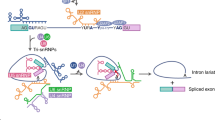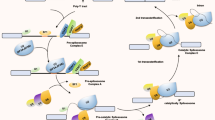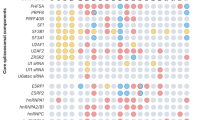Abstract
The biological diversity of prostate cancer confounds standardization of therapy. Advances in molecular profiling suggest that differences in the genetic composition of tumors significantly contribute to the complexity of the disease. Alternative pre-mRNA splicing is a key genetic process underlying biological diversity. During alternative splicing, coding and noncoding regions of a single gene are rearranged to generate several messenger RNA transcripts yielding distinct protein isoforms with differing biological functions. Misregulation of the splicing machinery and mutations in key regulatory elements affect splicing of cancer-relevant genes. In prostate cancer, aberrant and alternative splicing generates proteins that influence cell phenotypes and survival of patients. Splicing events may be exploited for clinical benefit, and technological advances are beginning to uncover novel biomarkers and therapeutic targets. Since splicing mediates information transfer from the genome to the proteome, it adds an important dimension to '-omics'-based molecular signatures used to individualize care of patients.
This is a preview of subscription content, access via your institution
Access options
Subscribe to this journal
Receive 12 print issues and online access
$189.00 per year
only $15.75 per issue
Buy this article
- Purchase on SpringerLink
- Instant access to full article PDF
Prices may be subject to local taxes which are calculated during checkout




Similar content being viewed by others
References
Heidenreich, A. et al. EAU guidelines on prostate cancer. Eur. Urol. 53, 68–80 (2008).
Vickers, A. J. & Lilja, H. Prostate cancer: estimating the benefits of PSA screening. Nat. Rev. Urol. 6, 301–303 (2009).
Witte, J. S. Prostate cancer genomics: towards a new understanding. Nat. Rev. Genet. 10, 77–82 (2009).
Pennisi, E. Why do humans have so few genes? Science 309, 80 (2005).
Stamm, S. et al. Function of alternative splicing. Gene 344, 1–20 (2005).
Pan, Q., Shai, O., Lee, L. J., Frey, B. J. & Blencowe, B. J. Deep surveying of alternative splicing complexity in the human transcriptome by high-throughput sequencing. Nat. Genet. 40, 1413–1415 (2008).
Venables, J. P. Aberrant and alternative splicing in cancer. Cancer Res. 64, 7647–7654 (2004).
Hanahan, D. & Weinberg, R. A. The hallmarks of cancer. Cell 100, 57–70 (2000).
Wang, J. et al. Pleiotropic biological activities of alternatively spliced TMPRSS2/ERG fusion gene transcripts. Cancer Res. 68, 8516–8524 (2008).
Tomlins, S. A. et al. ETS gene fusions in prostate cancer: from discovery to daily clinical practice. Eur. Urol. doi:10.1016/j.eururo.2009.04.036 (2009).
Sahadevan, K. et al. Selective overexpression of fibroblast growth factor receptors 1 and 4 in clinical prostate cancer. J. Pathol. 213, 82–90 (2007).
Gnanapragasam, V. J. et al. FGF8 isoform b expression in human prostate cancer. Br. J. Cancer 88, 1432–1438 (2003).
Mercatante, D. R., Mohler, J. L. & Kole, R. Cellular response to an antisense-mediated shift of Bcl-x pre-mRNA splicing and antineoplastic agents. J. Biol. Chem. 277, 49374–49382 (2002).
Woolard, J. et al. VEGF165b, an inhibitory vascular endothelial growth factor splice variant: mechanism of action, in vivo effect on angiogenesis and endogenous protein expression. Cancer Res. 64, 7822–7835 (2004).
Pajares, M. J. et al. Alternative splicing: an emerging topic in molecular and clinical oncology. Lancet Oncol. 8, 349–357 (2007).
Srebrow, A. & Kornblihtt, A. R. The connection between splicing and cancer. J. Cell Sci. 119, 2635–2641 (2006).
Narla, G. et al. A germline DNA polymorphism enhances alternative splicing of the KLF6 tumor suppressor gene and is associated with increased prostate cancer risk. Cancer Res. 65, 1213–1222 (2005).
Narla, G. et al. KLF6-SV1 overexpression accelerates human and mouse prostate cancer progression and metastasis. J. Clin. Invest. 118, 2711–2721 (2008).
Wang, G. S. & Cooper, T. A. Splicing in disease: disruption of the splicing code and the decoding machinery. Nat. Rev. Genet. 8, 749–761 (2007).
Grosso, A. R., Martins, S. & Carmo-Fonseca, M. The emerging role of splicing factors in cancer. EMBO Rep. 9, 1087–1093 (2008).
Ghigna, C. et al. Cell motility is controlled by SF2/ASF through alternative splicing of the Ron protooncogene. Mol. Cell. 20, 881–890 (2005).
Karni, R. et al. The gene encoding the splicing factor SF2/ASF is a proto-oncogene. Nat. Struct. Mol. Biol. 14, 185–193 (2007).
Rajan, P. et al. The RNA-binding and adaptor protein Sam68 modulates signal-dependent splicing and transcriptional activity of the androgen receptor. J. Pathol. 215, 67–77 (2008).
Clark, E. L. et al. The RNA helicase p68 is a novel androgen receptor co-activator involved in splicing and is overexpressed in prostate cancer. Cancer Res. 68, 7938–7946 (2008).
Ule, J., Jensen, K., Mele, A. & Darnell, R. B. CLIP: a method for identifying protein–RNA interaction sites in living cells. Methods 37, 376–386 (2005).
Segal, E., Friedman, N., Kaminski, N., Regev, A. & Koller, D. From signatures to models: understanding cancer using microarrays. Nat. Genet. 37 (Suppl.), S38–S45 (2005).
Li, H. R. et al. Two-dimensional transcriptome profiling: identification of messenger RNA isoform signatures in prostate cancer from archived paraffin-embedded cancer specimens. Cancer Res. 66, 4079–4088 (2006).
Zhang, C. et al. Profiling alternatively spliced mRNA isoforms for prostate cancer classification. BMC Bioinformatics 7, 202 (2006).
Shendure, J. & Ji, H. Next-generation DNA sequencing. Nat. Biotechnol. 26, 1135–1145 (2008).
Li, H. et al. Determination of tag density required for digital transcriptome analysis: application to an androgen-sensitive prostate cancer model. Proc. Natl Acad. Sci. USA 105, 20179–20184 (2008).
Brinkman, B. M. Splice variants as cancer biomarkers. Clin. Biochem. 37, 584–594 (2004).
Heuze-Vourc'h, N., Leblond, V. & Courty, Y. Complex alternative splicing of the hKLK3 gene coding for the tumor marker PSA (prostate-specific-antigen). Eur. J. Biochem. 270, 706–714 (2003).
Ponta, H., Sherman, L. & Herrlich, P. A. CD44: from adhesion molecules to signaling regulators. Nat. Rev. Mol. Cell Biol. 4, 33–45 (2003).
Muraki, M. et al. Manipulation of alternative splicing by a newly developed inhibitor of Clks. J. Biol. Chem. 279, 24246–24254 (2004).
Mercatante, D. R., Bortner, C. D., Cidlowski, J. A. & Kole, R. Modification of alternative splicing of Bcl-x pre-mRNA in prostate and breast cancer cells. Analysis of apoptosis and cell death. J. Biol. Chem. 276, 16411–16417 (2001).
Brambilla, C. et al. Oligomer-mediated modulation of hTERT alternative splicing induces telomerase inhibition and cell growth decline in human prostate cancer cells. Cell. Mol. Life Sci. 61, 1764–1774 (2004).
Tijink, B. M. et al. A phase I dose escalation study with anti-CD44v6 bivatuzumab mertansine in patients with incurable squamous cell carcinoma of the head and neck or esophagus. Clin. Cancer Res. 12, 6064–6072 (2006).
Thorsen, K. et al. Alternative splicing in colon, bladder, and prostate cancer identified by exon-array analysis. Mol. Cell. Proteomics 7, 1214–1224 (2008).
Skotheim, R. I. & Nees, M. Alternative splicing in cancer: noise, functional, or systematic? Int. J. Biochem. Cell Biol. 39, 1432–1449 (2007).
Eeles, R. A. et al. Multiple newly identified loci associated with prostate cancer susceptibility. Nat. Genet. 40, 316–321 (2008).
Varambally, S. et al. Integrative genomic and proteomic analysis of prostate cancer reveals signatures of metastatic progression. Cancer Cell 8, 393–406 (2005).
Sreekumar, A. et al. Metabolomic profiles delineate potential role for sarcosine in prostate cancer progression. Nature 457, 910–914 (2009).
Carstens, R. P., Wagner, E. J. & Garcia-Blanco, M. A. An intronic splicing silencer causes skipping of the IIIb exon of fibroblast growth factor receptor 2 through involvement of polypyrimidine tract binding protein. Mol. Cell Biol. 20, 7388–7400 (2000).
Black, D. L. Mechanisms of alternative pre-messenger RNA splicing. Annu. Rev. Biochem. 72, 291–336 (2003).
Matlin, A. J., Clark, F. & Smith, C. W. Understanding alternative splicing: towards a cellular code. Nat. Rev. Mol. Cell Biol. 6, 386–398 (2005).
Stamm, S. Signals and their transduction pathways regulating alternative splicing: a new dimension of the human genome. Hum. Mol. Genet. 11, 2409–2416 (2002).
Matter, N., Herrlich, P. & Konig, H. Signal-dependent regulation of splicing via phosphorylation of Sam68. Nature 420, 691–695 (2002).
Acknowledgements
P. Rajan was supported during a recent PhD tenure by a Medical Research Council Clinical Research Training Fellowship and a Royal College of Surgeons of England Surgical Research Fellowship. D. J. Elliott and H. Y. Leung currently hold an Association for International Cancer Research project grant.
Author information
Authors and Affiliations
Corresponding author
Ethics declarations
Competing interests
The authors declare no competing financial interests.
Rights and permissions
About this article
Cite this article
Rajan, P., Elliott, D., Robson, C. et al. Alternative splicing and biological heterogeneity in prostate cancer. Nat Rev Urol 6, 454–460 (2009). https://doi.org/10.1038/nrurol.2009.125
Issue date:
DOI: https://doi.org/10.1038/nrurol.2009.125
This article is cited by
-
Identification and characterization of novel ETV4 splice variants in prostate cancer
Scientific Reports (2023)
-
The aberrant upregulation of exon 10-inclusive SREK1 through SRSF10 acts as an oncogenic driver in human hepatocellular carcinoma
Nature Communications (2022)
-
Androgen receptor and its splice variant, AR-V7, differentially induce mRNA splicing in prostate cancer cells
Scientific Reports (2021)
-
Age-related injury responses of human oligodendrocytes to metabolic insults: link to BCL-2 and autophagy pathways
Communications Biology (2021)
-
Profiles of miRNA Isoforms and tRNA Fragments in Prostate Cancer
Scientific Reports (2018)



